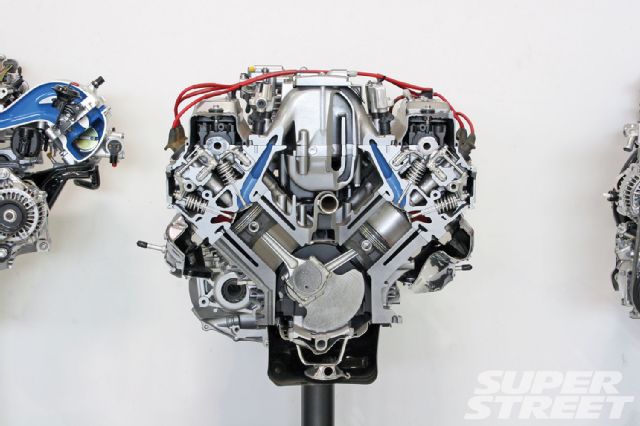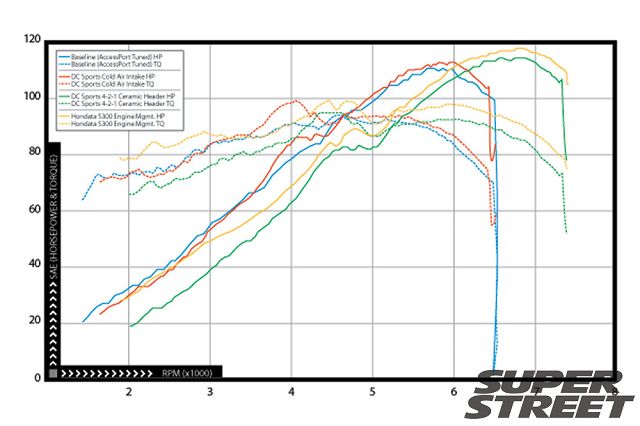 |
| Work
Anytime force—either a push or a pull-is applied to an object and an opposite reaction takes place, work happens. For example, when meathead's El Camino breaks down and he pushes it home, work occurs. But when meathead's mother won't get out of the passenger seat and the El Camino won't budge, work doesn't happen, despite meathead's effort. Mathematically speaking, work is simply the distance moved multiplied by the force applied or, in the case of the El Camino, however far away mom's house is multiplied by the weight of the half-truck. The answer is typically expressed in feet per pound or ft-lb for short.
 |
| Torque
Work happens in a straight line but almost everything that has to do with your engine takes place around a circular axis. This twisting force you care about is torque and is measured by units of force multiplied by an object's distance from its axis of rotation. Since whatever engine you've got has some sort of rotating assembly, calculating its torque is a bit more complicated than figuring out how far the boob down the block pushed the El Camino. Here, the distance moved is equal to the circumference of a circle, which is the pattern the crankshaft and pistons follow when in motion. The same calculation can be used when tightening hardware since, like the crankshaft, nuts and bolts also spin according to a circular motion. For example, if you use a one-foot-long ratchet to tighten a bolt using 10 pounds of force, you've applied 10 lb-ft of torque to it. Double the length of the ratchet and apply the same amount of force and you've just applied 20 lb-ft of torque. (Notice that work is ft-lb and torque is lb-ft.)
Despite what you think you know, your engine doesn't make horsepower; instead, it converts fuel into torque. All of this happens when combustion occurs, the piston moves down and the crankshaft rotates. It's the crankshaft's reciprocating motion that transmits torque onto the drivetrain and makes everything go. If your engine lays down 100 lb-ft of torque, then all that means is that 100 pounds of force by means of a one-foot lever is required to bring it all to a stop. Unlike work, though, movement need not necessarily occur for torque to be applied. See for yourself; set your torque wrench to 40 lb-ft and try tightening a bolt that's already been torqued to 70 lb-ft. Torque is still applied here even though the bolt hasn't moved.
Horsepower
Work and torque tell you what's been done but horsepower tells you how quickly we can do it. Horsepower measures an object's ability to move a certain amount of weight a given distance. In other words, it tells you how long it takes to apply a specific amount of leverage. The more power there is, the more work can be done during a given period of time. It's an arbitrary system of measurement if there ever was one. James Watt—whose surname is the official S.I. (Systeme International des Unites) symbol for power, developed the concept in the late-1700s after replacing machinery originally driven by horses with a steam engine. It was only logical then for Watt to conclude how many horses' worth of labor the steam engine could accomplish and name all of this what he did. Today, horsepower is the generally accepted unit of measurement to explain the rate at which work is done. And because one of Watt's horses says that's the way it ought to be, one horsepower is equal to the amount of power it takes to perform 33,000 ft-lb of work in a single minute. In other words, one horsepower is equal to the amount of energy required to lift 550 pounds one foot in one second.
To put horsepower into perspective, imagine for a minute that your Civic broke down alongside meathead's El Camino, and imagine for a minute that both cars weigh exactly the same. Meathead's muscles give him the advantage here, and because the El Camino makes it home twice as fast as the Civic, we can conclude that meathead's got twice as much power as you despite equal amounts of force.
 |
|  |
| Making Sense of it All
You wouldn't be entirely wrong to assume that torque gets things moving and that horsepower keeps it that way. Torque is what brings your car from a dead stop, but because of gearing and all sorts of science that Sir Isaac Newton says is true, becomes less relevant as acceleration increases. A little bit of math later and all of a sudden that 550 ft-lb of work turns into the number 5,252 and is exactly how dynos convert torque into numbers that you and your ego care about. More specifically, horsepower is equal to torque multiplied by engine speed all divided by 5,252. You don't need to understand the math to see that horsepower and torque need each other. You can't change one without the other. It turns out that 5,252 is even more special than you think. Below 5,252 rpm, an engine's torque is always numerically higher than its horsepower, whether we're talking about 1970s car-trucks or Japanese people movers. Above 5,252 rpm the roles are reversed. The relationship between horsepower and torque is more than tidy math, though, and meatheads with El Caminos proclaiming that torque trumps horsepower won't soon quiet down. But meathead isn't all wrong. After all, it takes torque to make horsepower.
 |
| Stare at the math long enough and a couple of things become obvious. First, at 5,252 rpm, horsepower and torque are always equal, despite the engine, displacement, or number of cylinders. Second, aside from increasing torque, increasing engine speed is the easiest and most logical way to make more horsepower. That's precisely how otherwise comparatively smaller but still powerful Formula One engines that spin to 18,000rpm work. Finally, when it comes to naturally aspirated engines, there's no way of getting around the fact that displacement matters. After all, you can only wind an engine out so high before, at best, valve float occurs. The size of an engine is directly proportional to the amount of torque it'll produce as well as its efficiency. Once you're moving, though, it's horsepower that keeps you going and what gets you there before the El Camino. Don't be fooled into thinking that torque is sacrificed here, though. Instead, peak torque often remains the same but is simply shifted to a higher engine speed.
Our friend with the El Camino is right about one thing: torque is good. But so is horsepower. And unless you're towing, hauling heavy loads or climbing steep hills, in which case you'd probably be reading about lift kits and knobby tires right now, then you ought to be concerned about horsepower. All of this can be very misleading; especially when your back's planted against the seat of something motivated by 500 cubic inches of cast-iron torque. But don't mistake a significant helping of instantaneous response as being eminent to something less torquey but with exponentially more horsepower. You'll lose that battle, and quite possibly end up living with your mother at 44.
 |
| 